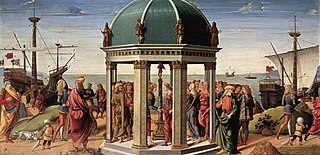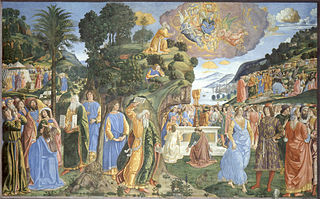 W
WBiagio d’Antonio Tucci was an Italian Renaissance painter active in Florence, Faenza and Rome.
 W
WAlessandro di Mariano di Vanni Filipepi, known as Sandro Botticelli, was an Italian painter of the Early Renaissance. Botticelli's posthumous reputation suffered until the late 19th century, when he was rediscovered by the Pre-Raphaelites who stimulated a reappraisal of his work. Since then, his paintings have been seen to represent the linear grace of Early Renaissance painting.
 W
WPietro Perugino, born Pietro Vannucci, was an Italian Renaissance painter of the Umbrian school, who developed some of the qualities that found classic expression in the High Renaissance. Raphael was his most famous pupil.
 W
WCosimo Rosselli (1439–1507) was an Italian painter of the Quattrocento, active mainly in his birthplace of Florence, but also in Pisa earlier in his career in 1481-82 in the Sistine Chapel in Rome, where he painted some of the large frescoes on the side walls. Though generally regarded as a lesser talent in comparison to Sandro Botticelli, Pietro Perugino and Domenico Ghirlandaio, who were all also active at the Sistine Chapel, Rosselli was still able to win large and important commission throughout his career, a testament to his high level of activity in his native Florence. Important local commissions include a fresco in the cloister of Santissima Annunziata, Florence and those in the Chapel of the Holy Blood in Sant'Ambrogio, Florence.
 W
WThe Baptism of Christ is a fresco by the Italian Renaissance painter Pietro Perugino and his workshop, executed around 1482 and located in the Sistine Chapel, Rome.
 W
WThe Crossing of the Red Sea is a fresco executed in 1481–1482 and located in the Sistine Chapel, Vatican City. Of uncertain attribution, it has been assigned to one between Domenico Ghirlandaio, Biagio d'Antonio or Cosimo Rosselli.
 W
WThe Delivery of the Keys, or Christ Giving the Keys to St. Peter is a fresco by the Italian Renaissance painter Pietro Perugino, executed in 1481–1482 and located in the Sistine Chapel, Rome.
 W
WThe Descent from Mount Sinai is a fresco by the Italian Renaissance painter Cosimo Rosselli and his assistants, executed in 1481–1482 and located in the Sistine Chapel, Rome. It depicts the prophet Moses in the process of receiving and introducing the Ten Commandments.
 W
WThe Last Supper is a fresco by the Italian Renaissance painters Cosimo Rosselli and Biagio d'Antonio, executed in 1481–1482 and located in the Sistine Chapel, Rome.
 W
WMoses Leaving for Egypt is a fresco by the Italian Renaissance painter Pietro Perugino and his workshop, executed around 1482 and located in the Sistine Chapel, Rome. It depicts a journey by the prophet Moses.
 W
WThe Punishment of the Sons of Korah or Punishment of the Rebels is a fresco by the Italian Renaissance painter Sandro Botticelli, executed in 1480–1482 in the Sistine Chapel, Rome.
 W
WThe Raphael Cartoons are seven large cartoons for tapestries, belonging to the British Royal Collection but since 1865 on loan to the Victoria and Albert Museum in London, designed by the High Renaissance painter Raphael in 1515–16 and showing scenes from the Gospels and Acts of the Apostles. They are the only surviving members of a set of ten cartoons commissioned by Pope Leo X for the Sistine Chapel tapestries for the Sistine Chapel in the Vatican Palace, which are still hung below Michelangelo's famous ceiling. Reproduced in the form of prints, the tapestries rivalled Michelangelo's ceiling as the most famous and influential designs of the Renaissance, and were well known to all artists of the Renaissance and Baroque. Admiration of them reached its highest pitch in the 18th and 19th centuries; they were described as "the Parthenon sculptures of modern art".
 W
WThe Temptations of Christ is a fresco by the Italian Renaissance painter Sandro Botticelli, executed in 1480–1482 and located in the Sistine Chapel, Rome.
 W
WThe Testament and Death of Moses is a fresco attributed to the Italian Renaissance painters Luca Signorelli and Bartolomeo della Gatta, executed in around 1482 and located in the Sistine Chapel, Rome.
 W
WThe Vocation of the Apostles is a fresco by the Italian Renaissance painter Domenico Ghirlandaio, executed in 1481–1482 and located in the Sistine Chapel, Rome. It depicts the Gospel narrative of Jesus Christ calling Peter and Andrew to become his disciples.
 W
WThe Youth of Moses or The Trials of Moses is a fresco by the Italian Renaissance painter Sandro Botticelli and his workshop, executed in 1481–1482 in the Sistine Chapel, Rome.